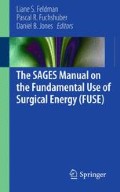Abstract
Different techniques of liver parenchymal transaction have been described, including finger fracture, sharp dissection, clamp-crush technique, the hydrojet, and more recently, the Cavitron Ultrasonic Surgical Aspirator (CUSA). The CUSA is an innovative tool for dissecting through the liver parenchyma, which can potentially reduce intraoperative blood loss and perioperative morbidity. The CUSA system is a powerful ultrasonic aspirator and dissector with a wide application not only in liver surgery but also in other surgical specialties as well. The CUSA is widely used in multiple surgical subspecialties, including neurosurgery, gastrointestinal, hepatobiliary surgery, gynecology, and urology. CUSA Excel is an ultrasonic surgical aspirator, where fragmentation, suction, and irrigation occur simultaneously, allowing the surgeon to remove tissue with accurate control. In liver surgery, it is an invaluable tool, particularly in a situation where the tumor is closely adjacent to a vital structure that needs to be saved. CUSA will enable dissection around any structure that needs to be preserved.
Access this chapter
Tax calculation will be finalised at checkout
Purchases are for personal use only
References
Chan KK, Watmough DJ, Hope DT, Moir K. A new motor-driven surgical probe and its in vitro comparison with the Cavitron Ultrasonic Surgical Aspirator. Ultrasound Med Biol. 1986;12(4):279–83.
Chopp RT, Shah BB, Addonizio JC. Use of ultrasonic surgical aspirator in renal surgery. Urology. 1983;22(2):157–9.
Deppe G, Malviya VK, Malone Jr JM. Use of Cavitron Ultrasonic Surgical Aspirator (CUSA) for palliative resection of recurrent gynecologic malignancies involving the vagina. Eur J Gynaecol Oncol. 1989;10(1):1–2.
Deppe G, Malviya VK, Malone Jr JM. Debulking surgery for ovarian cancer with the Cavitron Ultrasonic Surgical Aspirator (CUSA)—a preliminary report. Gynecol Oncol. 1988;31(1):223–6.
Farid H, O’Connell T. Hepatic resections: changing mortality and morbidity. Am Surg. 1994;60(10):748–52.
Fasulo F, Giori A, Fissi S, Bozzetti F, Doci R, Gennari L. Cavitron Ultrasonic Surgical Aspirator (CUSA) in liver resection. Int Surg. 1992;77(1):64–6.
Freysdottir D, Nielsson J, Magnusson J. Hepatic resections. The results of using CUSA. Laeknabladid. 1994;80(9):465–70.
Hardy KJ, Martin J, Fletcher DR, MacLellan DG, Jones RM. Hepatic resection: value of operative ultrasound and ultrasonic dissection. Aust N Z J Surg. 1989;59(8):621–3.
Koo BN, Kil HK, Choi JS, Kim JY, Chun DH, Hong YW. Hepatic resection by the Cavitron Ultrasonic Surgical Aspirator increases the incidence and severity of venous air embolism. Anesth Analg. 2005;101(4):966–70.
Lee JH, Kwon TD, Kim HJ, Kang B, Koo BN. Multiple cerebral infarction and paradoxical air embolism during hepatectomy using the Cavitron Ultrasonic Surgical Aspirator—a case report. Korean J Anesthesiol. 2010;59(Suppl):S133–6.
Little JM, Hollands MJ. Impact of the CUSA and operative ultrasound on hepatic resection. HPB Surg. 1991;3(4):271–7.
Morishita Y, Konishi I, Noda Y, Mori T. Usage of the CUSA (cavitron ultrasonic surgical aspirator) in radical surgery of cervical carcinoma of the uterus. Gan To Kagaku Ryoho. 1987;14(5):1494–500.
Nagano Y, Matsuo K, Kunisaki C, Ike H, Imada T, Tanaka K, Togo S, Shimada H. Practical usefulness of ultrasonic surgical aspirator with argon beam coagulation for hepatic parenchymal transaction. World J Surg. 2005;29(7):899–902.
Pamecha V, Gurusamy KS, Sharma D, Davidson BR. Techniques for liver parenchymal transaction: a meta-analysis of randomized controlled trials. HPB. 2009;11(4):275–81.
Storck BH, Rutgers EJ, Gortzak E, Zoetmulder FA. The impact of the CUSA ultrasonic dissection device on major liver resections. Neth J Surg. 1991;43(4):99–101.
Yamamoto Y, Ikai L, Kume M, Sakai Y, et al. New simple technique for hepatic parenchymal resection using a Cavitron Ultrasonic Surgical Aspirator and bipolar cautery equipped with a channel for water dripping. World J Surg. 1999;23(10):1032–7.
Author information
Authors and Affiliations
Editor information
Editors and Affiliations
Rights and permissions
Copyright information
© 2012 Springer Science+Business Media, LLC
About this chapter
Cite this chapter
Choi, J.S. (2012). Cavitron Ultrasonic Surgical Aspirator. In: Feldman, L., Fuchshuber, P., Jones, D. (eds) The SAGES Manual on the Fundamental Use of Surgical Energy (FUSE). Springer, New York, NY. https://doi.org/10.1007/978-1-4614-2074-3_8
Download citation
DOI: https://doi.org/10.1007/978-1-4614-2074-3_8
Published:
Publisher Name: Springer, New York, NY
Print ISBN: 978-1-4614-2073-6
Online ISBN: 978-1-4614-2074-3
eBook Packages: MedicineMedicine (R0)

